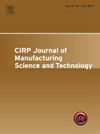Machinability analysis of UD-GFRP composites in edge trimming with diamond-coated burr tools at various fiber orientations
IF 5.4
2区 工程技术
Q2 ENGINEERING, MANUFACTURING
CIRP Journal of Manufacturing Science and Technology
Pub Date : 2025-04-05
DOI:10.1016/j.cirpj.2025.03.008
引用次数: 0
Abstract
Machining operations that are usually required during the manufacturing process of fiber-reinforced polymers (FRPs) are likely to generate numerous specific defects on the machined parts. Cutting tools with specific geometries, such as burr tools with many pyramidal teeth, help to reduce this type of defect. Previous studies in milling with this kind of tool focused mainly on multidirectional (MD) FRP composites. However, it is well known that fiber orientation is a critical parameter in FRP machining. Accordingly, this paper presents a machinability analysis of unidirectional (UD) FRP composites in edge trimming at various fiber orientations, for the specific case of burr tools. Edge trimming experiments are conducted using glass fiber reinforced polymer (GFRP) composites and diamond-coated burr tools. For each machining test, cutting forces, machined surface temperature and surface quality are quantified, as well as defects on external plies, which are characterized with a device specifically developed for this purpose. The results demonstrate that all the parameters are affected greatly by fiber orientation. The maximum temperature rise and the resultant force generally move in the same direction. The surface irregularities, and the maximum rise in temperature, move globally in opposite directions. Uncut fibers on the lower face of the workpiece are related to axial forces and may be facilitated by high temperatures. Moreover, the effect of fiber orientation on cutting forces in the workpiece plane, machined surface temperature and surface quality is analogous to previous literature on orthogonal cutting.
金刚石涂层毛刺刀对UD-GFRP复合材料在不同纤维取向上的切削性能分析
在纤维增强聚合物(frp)的制造过程中通常需要的加工操作可能会在加工零件上产生许多特定的缺陷。具有特定几何形状的切削工具,例如带有许多锥体齿的毛刺工具,有助于减少这种类型的缺陷。以往的铣削研究主要集中在多向(MD) FRP复合材料上。然而,众所周知,纤维取向是玻璃钢加工中的一个关键参数。因此,本文针对毛刺刀具的具体情况,对单向(UD) FRP复合材料在不同纤维方向的边缘修整进行了可加工性分析。采用玻璃纤维增强聚合物(GFRP)复合材料和金刚石涂层毛刺工具进行了边缘修剪实验。对于每个加工测试,切削力、加工表面温度和表面质量以及外部层上的缺陷都是量化的,这些都是用专门为此目的开发的装置来表征的。结果表明,光纤取向对各参数影响较大。最高温升和合力通常在同一方向上运动。表面的不规则和温度的最大上升,在全球范围内朝着相反的方向移动。工件下表面未切割的纤维与轴向力有关,并且可能在高温下易于切割。此外,纤维取向对工件平面切削力、加工表面温度和表面质量的影响与以往正交切削文献相似。
本文章由计算机程序翻译,如有差异,请以英文原文为准。
求助全文
约1分钟内获得全文
求助全文
来源期刊

CIRP Journal of Manufacturing Science and Technology
Engineering-Industrial and Manufacturing Engineering
CiteScore
9.10
自引率
6.20%
发文量
166
审稿时长
63 days
期刊介绍:
The CIRP Journal of Manufacturing Science and Technology (CIRP-JMST) publishes fundamental papers on manufacturing processes, production equipment and automation, product design, manufacturing systems and production organisations up to the level of the production networks, including all the related technical, human and economic factors. Preference is given to contributions describing research results whose feasibility has been demonstrated either in a laboratory or in the industrial praxis. Case studies and review papers on specific issues in manufacturing science and technology are equally encouraged.
 求助内容:
求助内容: 应助结果提醒方式:
应助结果提醒方式:


